|
| |||
|
Apples
Blueberries |
The ManyTracks Orchard CrabApples
Generic seedlings planted on the homestead early 1980's, along with many wild seedlings and offspring |
Akero |
Hoholik |
|
2019 Emma's Crabapple As I mentioned in the Spiced Crabapples article below (4th paragraph) I have a particular interest in this old crabapple tree down the road, part of a local farm family's orchard probably from the '30's or '40's. We have a lot of seedling crabapples on our property, some we planted, some the birds and animals, and the trees themselves, planted. But only one tree has crabs larger than 1" and I wanted another for when the urge to make Spiced Crabapples took hold. Maybe I'd even make some crabapple jelly some day. Plus I simply desired to extend the life of this variety since we thought highly of the owner and enjoyed knowing her during our early years on the homestead. So in late winter I climbed up on the very high snowbanks and nipped off some scions. Half the tree is dead but I found some reasonably good pieces of last year growth. When we grafted our trees the end of May those pieces found their way onto a medium sized crabapple growing inside the orchard fence. It took and grew well this season.
Last fall when I harvested these crabs I planted a few of the seeds in the nursery in the garden. They grew well and I transplanted two of the best, one inside the fence of the main orchard and one in the North orchard. They both are doing fine. It will be a long time before we see fruit on them! But it is fun watching them grow. Later note: In 2021 I transplanted one last seedling out of the nursery, so there are now three growing. Mr.C Crabapple
The name is from our first cat on the homestead, a yellow and white male who arrived on his own early on in our life here, who adopted us and we him. We named him Mr.C, the first of many wonderful feline companions here. The name seemed appropriate for this small yellow wild apple, though Mr.C was neither small nor wild (he had simply decided to leave the place he had been living and come live with us). But I do think of him when this hardy tree puts out its annual crop so generously, as Mr.C was so generous to us with his companionship. See "MrC" page for more on this apple. June 8, 2019 -- Blossom Explosion
2018-2019 -- Crabapple Rootstock
Grafting came to the homestead initially due mostly thanks to stem
borers. They had done a thorough job on a number of newly planted apple
trees that I had purchased and the trees didn't survive. After that I
learned about the culprits and took care to protect future trees from
them. But the rootstocks of those trees that died grew up strong and
healthy and the idea of grafting took hold. They soon sported grafts of
named varieties and I began looking for more rootstocks to graft more
trees to. I didn't have to look too far, just around our property. I've
dug and transplanted many of wild seedlings since then, and we have many
dozens of trees grafted and growing on them. Mostly I can't tell at such
a young age if the young seedling is a wild apple (larger than 2") or a
crabapple (smaller than 2"). Sometimes I leave one branch of the
original seedling rootstock when we graft to let it grow and see what it
is. It could always be a good eating apple itself; we have a number of
good wild apples here. But mostly I think they are small crabs as we
have even more of those and seedlings are plentiful.
This wild crab was conveniently growing in the "new" orchard. It also had great form and branches to graft to. Maybe too convenient! It has four varieties grafted to it (marked with painted clothespins) (I promised not to add any more), growing well, and last year the young volunteer tree fruited for the first time - beautiful small bright 1" yellow and red crabs (used that year in the Spiced Crabapples below). I'll leave those top original branches for their lovely fruit. The reason I want to use local apple seedlings, crabs or regular, for grafting is because they have survived some winters already themselves and they have likely come from local producing trees which have proven themselves hardy and well adapted to our climate. It's a bummer to lose a healthy, growing graft because the rootstock winterkilled. There is some thought that the rootstock affects the quality of the fruit grafted to it, for ill or gain. I have a few varieties that are grafted to two or three different rootstocks, one of them being on a known bearing tree, the other on an unknown seedling and/or a common (Antonovka) rootstock. When these grafts bear fruit it will be very interesting to see the differences, if there is any. I expect there will be some difference because the trees are in different areas with differing amounts of hours of sun and micro-climates. It doesn't take much research to discover that the same named variety grown in different conditions, different climates, can bare very different fruit, not even considering the rootstock. The natural world does not embrace mono anything; it thrives and seems to thoroughly enjoy diversity. It sure would be boring if that weren't so! 2018 -- Spiced Crabapples - Nice Snack or Dinner Companion
This year I noticed one of the trees had particularly pretty, clean looking little 3/4 inch apples. It just seemed I should do something with them. Spiced Crabapples came to mind, though I’d never made nor tasted any. But it sounded good. I looked into my vast collection of three well worn preserving books and checked out their individual recipes - each one different from the others, no consensus here. So, checking out the ingredients I had on hand and my own venerable Sweet Sour Spiced Pickles recipe, I came up with my own recipe. Or at least a rough idea of what I might do. I started looking forward to having jars of Spiced Crabapples for gifts, if all turned out well. Time to pick the crabapples (September 29). Thankfully one doesn’t need many because they are a bit finicky, being so small. But it was a pleasant time looking at the trees and searching for suitable fruit. I passed up the really small 1/4 inch ones but chose four with nice 3/4 to 1 inch apples. All but one was outside our regular fenced area and the domain of wildlife. I only took a very small portion so there could be no complaints. The inside tree was a nice surprise. It is a wild seedling that we’ve grafted five different regular apples onto. But it still has a number of original branches and this was its first year to set fruit, confirming that it is indeed a crabapple, having very nice, clean, pretty yellow and red one inch fruit. I’ll be keeping some of those original branches now even as the regular apple scions grow. As I picked I kept the four groups separate (though in the end mixed them all together). I wondered if the 3/4" crabs might be a little small but they were a pretty dark red so I went for those, too. But that wasn’t all! I’d had my eye on another crabapple, though this one wasn’t mine. It was part of an old orchard down the road. All but the crab had been the domain of cattle for too many years and the apple trees were dead. The crab had ended up outside the fence near to the road and was still alive and putting out an anual crop of nice 1 1/2" fruit. I knew from past years that the pretty red and yellow now would turn entire beautiful red later. But they were tasty tart at this point and I decided to get some for my spiced crabapples. Unfortunately there were only a handful within my reach (being within my reach meant also being within deer reach, and they do love apples!). It was a small crop this year but there were more higher up. The tree had a high narrow crotch and I needed a boost to get up there to get a foothold. Steve patiently obliged and I managed to fill my pockets with enough good fruit, using my still willing booster to help me back down without bruising or smashing the pocketed apples. I guess I could have brought a bag. Next time. On down the road and home we went with bulging pockets. This tree is extra special to us as we knew the wonderful woman whose orchard it was part of. I can well imagine her making crabapple jelly and spiced crabapples. How I wish now that I'd had that interest when she was alive and I could have asked her. But her tree lives on, appropriately named (by me) Emma's Crabapple.
I made up my juice: 4c cider vinegar; 4c water, 4c sucanet (brown sugar) - that seemed good for a first try. In a little cloth bag (then into the juice) went 4 sticks broken up cinnamon stick, 1 tsp cloves, 1 tsp allspice. Onto the stove, bring to a boil, then simmer while getting everything else ready. Mostly that meant piercing each little crab with a large needle to keep them from bursting when cooked or canned. Or so they said. Much easier said than done. These are hard little apples! The instructions said to run a darning needle through several times. Maybe they had sharper darning needles and stronger hands. Maybe their apples were riper. I ended up using a cork on the hand end of the needle and simply stabbed the crabs several times (more times at the beginning, fewer as time and the number of little apples went on). When I got to the smallest 3/4" crabs I decided they could split if they wanted; I wasn’t going to stab any more. [I still don’t know how important this is; some split, some didn’t. Something to ‘research’ next year, next batch.]. At this point it was easy to decide to mix and cook the crabs all together, abandoning my idea of keeping the different sizes separate. So into the pot they all went to cook for a short time, maybe 3 minutes, that seemed like enough. My clean jars were ready; lids in hot water. I spooned out a few of the pretty, largest crabs into the first jar. They fell apart. Well, shoot. That wasn’t in my plan. They’d be good enough for us but not very pretty for gifts. And they were supposed to be the crown jewels of the lot. Oh well. I pulled all the large fruits out of the juice and into a bowl. Then proceeded to ladle the rest of the crabs into jars, working to get the little stems upright (so one could more easily pick them out of the jar to eat). This went OK. Brought the juice back to a boil, poured it over the little crabs in their respective jars, securely lidded then set aside on the counter to cool. Four pints and four half pints, plus one cup of leftover juice. As I cleaned up and the night went on we could hear the satisfying ting-pop as the jars cooled and the metal lids did their sealing bit. They all sealed and I was satisfied. The 1 1/2" crabs that fell apart maybe weren’t of company stock but they ate pretty good anyway! I’ll definitely go for more of them next time but will need to experiment to get the cooking time just right, firm enough to stay together but soft enough for easy eating. That’s the size most folks in years past (and present no doubt) would use; it’s faster. But the jars of smaller crabs came out just fine, too. Well, I think they are a bit strong flavored but my sister-in-law thinks they’re great just the way they are. I wouldn’t bother with the 3/4" sized ones next time; they’re pretty high percent core (though I just munch the whole thing) for the amount of work. I would again use the 1" size; they are easy little one bite snacks. Either eaten whole or "popped" off the core in your mouth. For all my interest and focus on apples this is the first time I’ve paid any attention to the culinary crabs. No longer! I now have plans to cut a few scions from that nice crab down the road and graft onto one of my trees next spring. And I’m looking for scions for a variety called Kerr. That one sounds good, though there are no doubt other good local crabs in the old orchards around if I just looked. One doesn’t need many crabs in the homestead orchard but there’s a reason the old home orchards all seem to have their one or two good crab trees. Copyright © Susan Robishaw |
|||
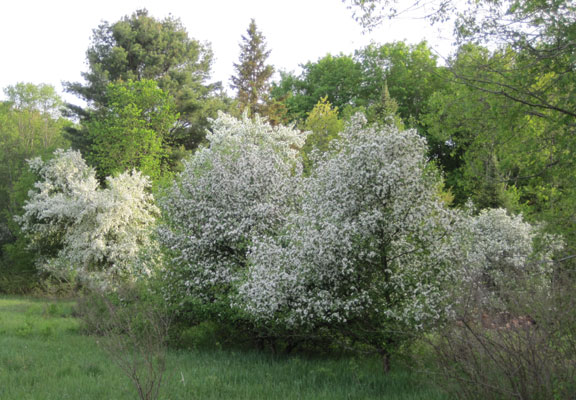
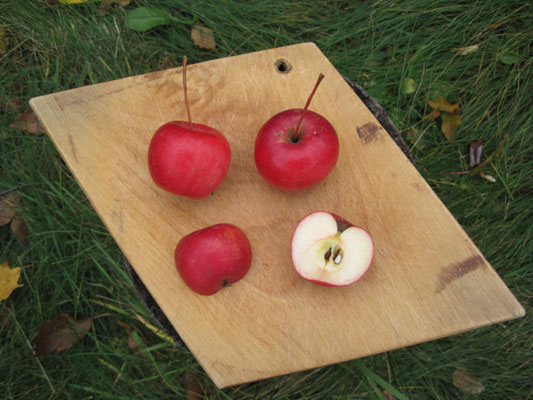 This
is a very nice 1 1/2" edible crab, pleasantly tart, not at all bitter or
astringent and I've wondered if it might be a named variety. Though I've
looked and inquired around I haven't had any luck matching it up to a
currently known variety. But since crabapples were once commonly planted
in most local orchards it could have simply been a seedling of another's
good crabapple, or it's a named variety that is no longer available in
the trade, if it ever was. Since I don't know, and it really doesn't
matter, I did what others have done all through the ages of growing
fruit trees - I named it myself, Emma's Crab, after the woman who, if
she didn't plant it did, I'm sure, made good use of the fruit for many,
many years. It's a lovely crabapple and she was a lovely woman. Thank
you Emma Hardy!
This
is a very nice 1 1/2" edible crab, pleasantly tart, not at all bitter or
astringent and I've wondered if it might be a named variety. Though I've
looked and inquired around I haven't had any luck matching it up to a
currently known variety. But since crabapples were once commonly planted
in most local orchards it could have simply been a seedling of another's
good crabapple, or it's a named variety that is no longer available in
the trade, if it ever was. Since I don't know, and it really doesn't
matter, I did what others have done all through the ages of growing
fruit trees - I named it myself, Emma's Crab, after the woman who, if
she didn't plant it did, I'm sure, made good use of the fruit for many,
many years. It's a lovely crabapple and she was a lovely woman. Thank
you Emma Hardy!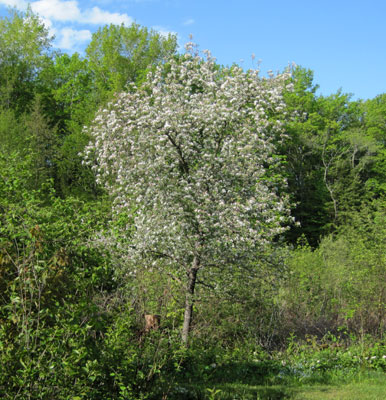 This
is a wilding growing not far from our house, just down the drive a ways, right
beside it, near enough to arch over and drop generous quantities of its fruit
into the mowed drive, much more convenient for the deer that those that drop
into the brush alongside. The 2" fruit was pretty much all yellow but lately it
has been blushed with red. A few years ago I took pruning saw and loppers to the
tree to untangle some of the fierce crossing and unruly habits of this wild
wood. I wasn't trying to tame it, just give some relief to the branches. I'd
always considered the fruit strictly for the deer and other creatures, yellow
and tart. But after the pruning the sun had a chance at getting to the fruit and
to my surprise red color appeared and the flavor improved dramatically. It could
also have been particularly good weather for this variety, but for whatever
reason it has, this year and last, been quite a tasty little bite, tart but with
enough sweetness and interesting flavor to attract my attention.
This
is a wilding growing not far from our house, just down the drive a ways, right
beside it, near enough to arch over and drop generous quantities of its fruit
into the mowed drive, much more convenient for the deer that those that drop
into the brush alongside. The 2" fruit was pretty much all yellow but lately it
has been blushed with red. A few years ago I took pruning saw and loppers to the
tree to untangle some of the fierce crossing and unruly habits of this wild
wood. I wasn't trying to tame it, just give some relief to the branches. I'd
always considered the fruit strictly for the deer and other creatures, yellow
and tart. But after the pruning the sun had a chance at getting to the fruit and
to my surprise red color appeared and the flavor improved dramatically. It could
also have been particularly good weather for this variety, but for whatever
reason it has, this year and last, been quite a tasty little bite, tart but with
enough sweetness and interesting flavor to attract my attention.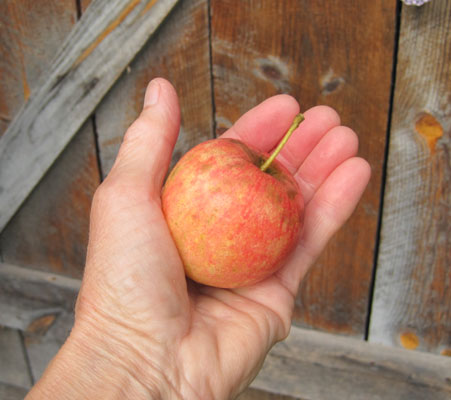 The
fruit is still the domain of the wildlife, however, thanks to its small size but
I've enjoyed quite a few snacks when walking by and the ripe fruit has dropped.
If it was a full sized apple the wildlife would have to share that harvest with
me! We don't drive down to the house very often (we park on the other side of
the cabin/shop building) so the creatures have time to enjoy the apples at their
leisure without them being applesauced by vehicle tires. This is a tree that
readily drops its fruit when ripe so this is an apple they enjoy as well, always
cleaning up the drops.
The
fruit is still the domain of the wildlife, however, thanks to its small size but
I've enjoyed quite a few snacks when walking by and the ripe fruit has dropped.
If it was a full sized apple the wildlife would have to share that harvest with
me! We don't drive down to the house very often (we park on the other side of
the cabin/shop building) so the creatures have time to enjoy the apples at their
leisure without them being applesauced by vehicle tires. This is a tree that
readily drops its fruit when ripe so this is an apple they enjoy as well, always
cleaning up the drops.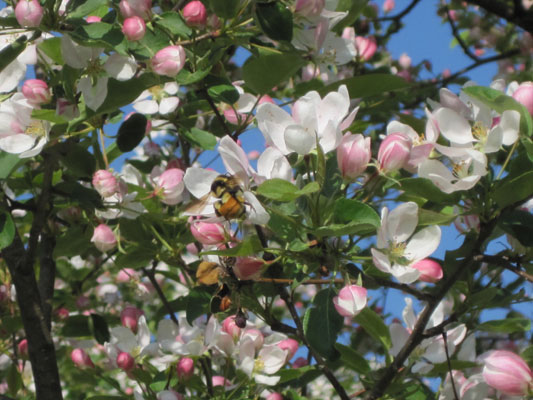 Many of the domestic apples joined in as well. It looks like it'll be a
very good apple year (maybe even enough for cider!). Thanks to human
interference, pruning them to keep them a more manageable size, and
their natural habits (with larger fruit in their future they wouldn't
want to be quite as prolific with the blossoming and fruiting as the
small crabs), they don't get to do quite the display but they sure come
close when it's an "on" year. Even a light year is gorgeous, apple
blossoms being natural beauties. I think every apple we have, save one,
is blossoming. Even a few grafts have their first blooms that will (I
hope) have fruit for the first time. And a couple of way-too-young
grafts couldn't help but get in the game with a surprise blossom or two.
They'll get to keep their first blooms for awhile but no fruit yet. But
I applaud them just the same. What an amazing and beautiful world.
Many of the domestic apples joined in as well. It looks like it'll be a
very good apple year (maybe even enough for cider!). Thanks to human
interference, pruning them to keep them a more manageable size, and
their natural habits (with larger fruit in their future they wouldn't
want to be quite as prolific with the blossoming and fruiting as the
small crabs), they don't get to do quite the display but they sure come
close when it's an "on" year. Even a light year is gorgeous, apple
blossoms being natural beauties. I think every apple we have, save one,
is blossoming. Even a few grafts have their first blooms that will (I
hope) have fruit for the first time. And a couple of way-too-young
grafts couldn't help but get in the game with a surprise blossom or two.
They'll get to keep their first blooms for awhile but no fruit yet. But
I applaud them just the same. What an amazing and beautiful world.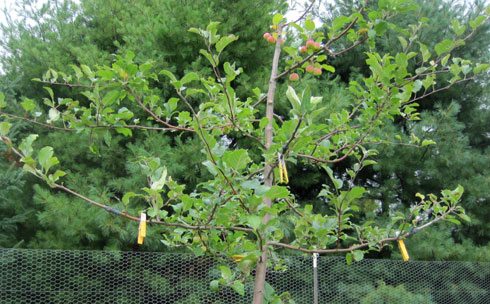
 We
are blessed with a wonderful and diverse collection of crabapples, some
bird planted, some we planted (almost 40 yrs ago), and progeny of both.
The trees vary in size and shape, the fruits vary in size and color.
I’ve never done anything with them but admire, thin out a few, taste the
fruits now and then (mostly tart), and appreciate how they feed the
small and large and inbetweens - birds, deer, squirrels, chipmunks. And
now - people!
We
are blessed with a wonderful and diverse collection of crabapples, some
bird planted, some we planted (almost 40 yrs ago), and progeny of both.
The trees vary in size and shape, the fruits vary in size and color.
I’ve never done anything with them but admire, thin out a few, taste the
fruits now and then (mostly tart), and appreciate how they feed the
small and large and inbetweens - birds, deer, squirrels, chipmunks. And
now - people! 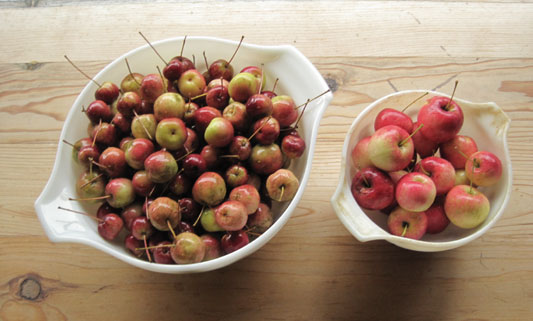 Back
in the kitchen I enjoyed sorting, measuring, washing my harvest. 1 1/2 c
of the 1" red & yellow clean orchard crabs; 2 1/2 c of the 3/4" dark red
with slight yellow fruit from the smallest north tree along the
driveway; 4 1/2 c of dull red & yellow 1" slightly sooty fruit from the
larger south tree; 2 c from the tree south of that one across the e-w
track, 1", similarly colored. Plus 3 1/2 c (17) of the large (as crabs
go) 1 1/2" clean red & yellow fruit from the old orchard (I need to find
out who originally planted this orchard so I can put an appropriate
‘local’ name to this tree). Such a pretty picture they made. It was
almost a shame to cook them. But what must be done must be done.
Back
in the kitchen I enjoyed sorting, measuring, washing my harvest. 1 1/2 c
of the 1" red & yellow clean orchard crabs; 2 1/2 c of the 3/4" dark red
with slight yellow fruit from the smallest north tree along the
driveway; 4 1/2 c of dull red & yellow 1" slightly sooty fruit from the
larger south tree; 2 c from the tree south of that one across the e-w
track, 1", similarly colored. Plus 3 1/2 c (17) of the large (as crabs
go) 1 1/2" clean red & yellow fruit from the old orchard (I need to find
out who originally planted this orchard so I can put an appropriate
‘local’ name to this tree). Such a pretty picture they made. It was
almost a shame to cook them. But what must be done must be done.